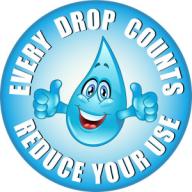Changing everything in our lives suddenly in attempt to live green, may be more than most of us can handle. We suggest making just one small change or adding one new habit every week. These little things add up to a big difference over time. This week let’s:
Save Water
Water Facts: 70% of our planet is covered by water. Only 2% of it is fresh. 1.6% of all fresh water is locked in polar ice caps and glaciers leaving the Earth with only 0.4% to survive on. Around 7 billion people now share that 0.4%. We should all conserve water, even in areas where water seems abundant.
Saving water will save you money on your utility bill, help prevent water pollution in nearby lakes, rivers and local watersheds. it may also help extend the life of your septic system by reducing soil saturation, and reducing any pollution due to leaks. Overloading municipal sewer systems can also cause untreated sewage to flow to lakes and rivers. The smaller the amount of water flowing through these systems, the lower the likelihood of pollution. In some communities, costly sewage system expansion has been avoided by community wide household water conservation.
Save water inside your home.
1. Check for drips and leaks. A small drip from a worn faucet can waste 20 gallons of water per day. Bigger leaks can waste hundreds if gallons.
- Check for leaks with your water meter. Read the meter before and after a three hour period when no water is used. If the reading aren’t the same, you have a leak somewhere.
- To check your toilet for leaks see conserve h2o’s instructions.
- Repair leaks ASAP.
2. Save toilet water.
- Only use the toilet as a toilet. Every time a toilet is used as an ashtray or garbage can, five to seven gallons of water is wasted.
- Consider buying a low-flush toilet.
- Convert your current toilet to save water.
3. Save shower water. Five to ten gallons of water are used for every minute that your shower is running. Consider:
- Taking shorter showers and turning off the water while lathering up.
- Installing water saving shower heads and low flow faucet aerators.
4. Save sink water.
In the bathroom:
- After you wet your toothbrush, turn the water off. Use a cup for rinsing.
- When you shave, partially fill the sink with a few inches of water to rinse your razor. It works just as well as running water.
In the kitchen:
- When washing dishes by hand, don’t leave the water running for rinsing. I gather my sponged dishes in a dish rack, then rinse them.
- Rinse vegetables and fruit in a pan of clean water
- Keep a bottle of drinking water in the refrigerator. Running water to cool it is wasteful.
- Minimize the use of your garbage disposal. They need a lot of water to run properly. Start a compost pile to dispose of food and fertilize your plants.
- Only use your dishwasher for full loads
5. Only run your clothes washer for full loads. Avoid using the Permanent Press Cycle because it uses 20 liters (5 gallons) more water. When it’s time to replace your washer, look for a front load Energy Star machine.
6. When you’re ready to have your floors and furniture professionally cleaned, choose a company that doesn’t waste water.
Save water outdoors and in your garden.
7. Plant drought resistant lawns and plants that will thrive where you live.
8. Use mulch around plants and trees to slow down evaporation and discourage weed growth
9. Position your sprinklers so water only goes where it is needed.
10. Water early in the day and avoid watering when it’s windy.
11. Don’t leave the hose running when washing your car. Use a bucket to apply the solution and turn the hose on when you’re ready to rinse.
12. Use a broom, not a hose to clean up outside.
Read 100+ Ways to Conserve Water. We hope this post helped you to think about the importance of saving water and small things you can do to help. We look forward to hearing your ideas and suggestions.
